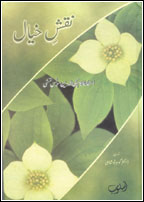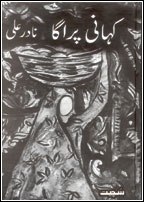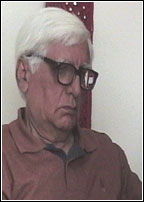 Although he is nearly 73,
there is something in his personality that makes you realise that time
has been quite benevolent to him. He looks still young, energetic and
full of life.
Although he is nearly 73,
there is something in his personality that makes you realise that time
has been quite benevolent to him. He looks still young, energetic and
full of life.
His sharp features and snow white hair are enough to label him a hero of
tinsel town. Nadir Ali oozes only warmth, love and softness. He likes to
keep himself busy and literature is what keeps him going.
His life appears to revolve around Punjabi literature. He could have
easily opted for Urdu literature but his mother tongue is the language
he chose to dabble in. Come rain or hailstorm, Nadir Ali writes Punjabi
poetry and fiction all the time.
Twice a week he attends a gathering called the ‘Sangat’ where other
Punjabi writers gather and analyse Punjabi literature with undying
devotion.
Before joining the cadre of writers, Nadir Ali served in the army and
rose to the position of colonel. He saw with his own eyes the drama that
unfolded in East Pakistan as he was serving there at the time of the
1971 debacle. That great tragedy took a heavy toll on him as he
submerged into sea of gloom. Literature rescued him at the time.
Then he met Najam Hosain Syed who changed the course of his life by
taking him under his wing. Najam Hosain Syed, a giant of a scholar and
lover of Punjabi literature, exhorted him to write. That’s how Nadir Ali
took to writing in Punjabi. He took his work seriously and, under the
guidance of his mentor, he has enriched Punjabi literature with his
poetry, as well as prose and literary criticism.
Even when he moved to the United States he did not sever links with
Punjabi. So far he has penned four books. Considering that he started
writing in 1973, his first book should have been published much earlier.
But it wasn’t until 1989 that he published a collection of his poetry
under the title Bol Choothay Tay Sachay.
At the same time, he penned many stories and thus a collection of
stories was published in 1995 under the title Kahani Kara. Another
collection titled Kahani Lekha followed suit in 2001. His recent
collection Kahani Paraga is the third book of his Punjabi stories.
 The book under review,
Kahani Paraga (Handful Stories), is a bit bulky as compared to his other
books. It contains 55 short, as well long, pieces of prose that revolve
around the rural ambience of Punjab. Some of the pieces are also auto-
biographical as the author has made good use of his military background.
The book under review,
Kahani Paraga (Handful Stories), is a bit bulky as compared to his other
books. It contains 55 short, as well long, pieces of prose that revolve
around the rural ambience of Punjab. Some of the pieces are also auto-
biographical as the author has made good use of his military background.
The collection contains Punjabi translations of the stories by Franz
Kafka and Margaret Green. Nadir Ali writes unadul-terated Punjabi and he
is also well aware of the idioms as well the adages that were in vogue
in rural Punjab. This enhances his prose no end. He has written Punjabi
which does not contain any Urdu words as he truly believes in the purity
of the language.
He has been able to paint the verdure land of five rivers with quite
finesse.
‘Sunj’ is the story of a retired man who lives alone in his house after
the death of his spouse. His serene routine gets the death blow when he
finds himself in some real trouble for no fault of his own. ‘Khaira
Annha’ is an interesting piece involving a blind man who acts as a blind
beggar to collect alms.
Ghulam Moheyddin Moonas Naqshi was a mystic and
like Sufi poets, he exhorts his audience to live their lives without
hurting anyone’s feelings. He believed in the higher values of life and
always reminded readers of the hereafter where one will have to answer
for their deeds.
At the end of the story, he reveals the real reason he
acts as a blind person. Other stories like ‘Pathar Day Insaan’, ‘Akhbar’,
‘Ronqa Ladla’ and others are good pieces. Nadir Ali has done well by
devoting himself to Punjabi language and literature. Punjabi, the 14th
most widely spoken language in the world, needs more dedicated writers
like Nadir Ali.
Born in 1904 in Amritsar, Ghulam Moheyddin Moonas Naqshi
became a poet after he came into contact with many giants of Punjabi
literature. At the time, conditions were very conducive for literary
pursuits. Lahore and Amritsar were the centres of Punjabi poetry and
legendary writers like Ustad Ferozuddin Tughrai, Mauala Baksh Kushta,
and Imam Din Sokhta did everything to promote new writers.
It is pertinent to note that Sufi Ghulam Mustafa Tabbasum was also a
pupil of Ferozuddin Tughrai. Naqshi too sat at the feet of a teacher
Ghulam Muhammad Tarannum and honed his skills in Punjabi poetry.
An extremely introvert soul, Naqshi was a carpet weaver by profession
and he had to face a tough time after Partition due to financial
constraints. It was his friend Munir Ahmad Tariq who got his slim book
published in 1959. Zarb-i-Hussain was the title of the book in which
Naqshi paid homage to Hazrat Imam Hussain and his disciples who gave
great sacrifices at Karbala. In 1960 Naqshi died after a protracted
illness and thus the chapter of his his life drew to a close.
He used to jot down his verses in diaries which were lost after his
death. Now, after many decades, his son has managed to lay his hands on
a few moth-eaten diaries of his father. The son, Dr Rasheed Amjad, who
is a celebrated Urdu short story writer, decided to get the contents of
the diaries published. Thus the book Naqsh-i-Khayal was born.
As one goes through his high quality Punjabi verse, it becomes apparent
that Naqshi was a mystic. Just like Sufi poets, he exhorts his audience
to live their lives without hurting anyone’s feelings.

He believed in the higher values of life and always reminded readers of
the hereafter where one will have to answer for their deeds. Dr Gohar
Naushahi has written an informative introduction to the poetry of Naqshi.
He has really made the matters easier for the readers by familiarising
them with the author.
Naqsh-i-Khayal should be read by all lovers of Punjabi as it contains
some fine Punjabi ghazals. Dr Rasheed Amjad has paid a true tribute to
his father by having his lost poetry published.
Kahani Paraga
By Nadir Ali
Suchet Kitab Ghar, Lahore
290pp. Rs200
Naqsh-i-Khayal
By Ustad Ghulam Moheyddin Moonas Naqshi
Edited by Dr Gohar Naushahi
Usloob, Islamabad
255pp. Rs160
BACK TO APNA WEB PAGE